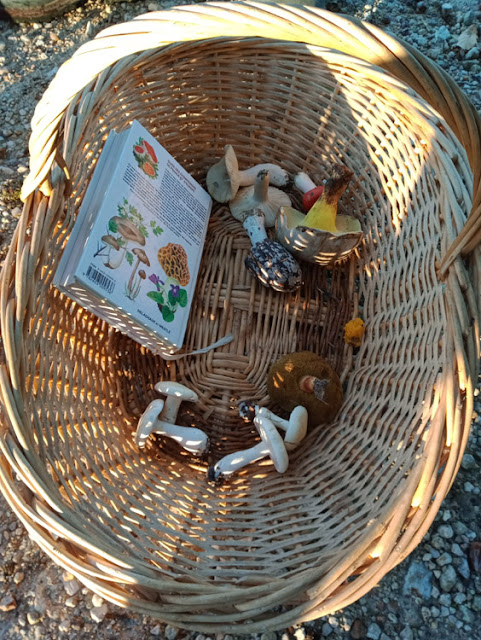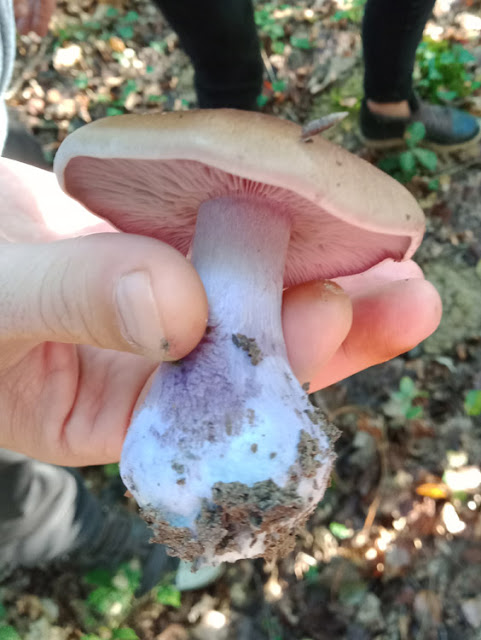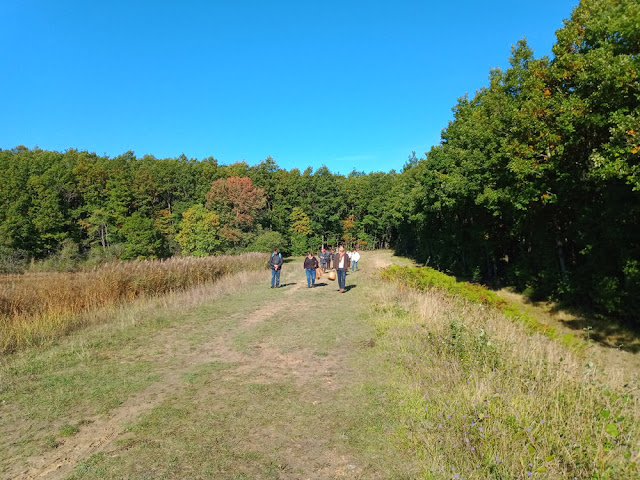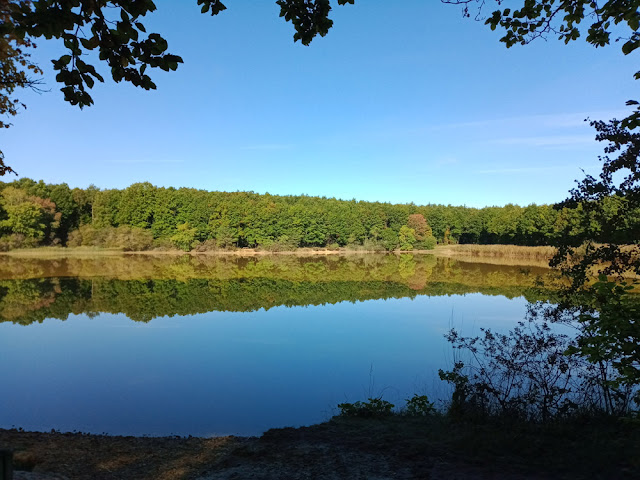On Tuesday 4 October fungi expert Didier led an outing to the Etang de Pas aux Anes in the Forest of Loches. Joining us was a group of disabled adults and their carers from a residential home called La Confluence, in Saint Cyr sur Loire.
 |
| A basket with mushrooms and a field guide. Species from top: Camembert Brittlegill Russula amoenolens (Fr. Russule à odeur de topinambour); Rosy Russula Russula lepida (syn R. rosea, Fr. Russule jolie); Rooting Bolete Boletus radicans (syn Caloboletus radicans, Fr. Bolet radicant) – bitter, light cap; Magpie Inkcap Coprinopsis picaceus (Fr. Coprin pie); Yellow Brain Tremella mesenterica (Fr. Beurre de sorcière); White Knight Tricholoma album (Fr. Tricholome blanc). |
 |
Suede Bolete Xerocomus subtomentosus (Fr. Bolet subtomenteux), not toxic, but not very interesting to eat.
|
 |
A mixed basket of mushrooms, including Beechwood Sickener Russula nobilis (Fr. Russule noble, with red cap, white flesh and blue stain reaction to sulphuric acid), a bouquet of Pholiotes [Update: Pholiotus gummosa] and a Panthercap Amanita pantherina (Fr. Amanite panthère).
|
 |
Matt Bolete Xerocomus pruinatus (syn Boletus pruinatus, Fr. Bolet pruineux), not toxic but not worth eating.
|
 |
Wood Blewit Clitocybe nuda (Fr. Pied bleu). Or is it?...
|
 |
Devils Fingers Clathrus archeri (Fr. Anthrus d'Archer), an Australian species believed to have arrived in France on sheeps wool fleeces destined for the woollen mills of the north-east of France.
|
 |
Walking along the dam wall of the Etang de Pas aux anes.
|
 |
Reflections on the Etang de Pas aux anes.
|
 |
Yellow Stainer Agaricus xanthodermus (Fr. Agaric jaunissante) looks like a delicious Field Mushroom, but it will give you a stomach ache.
|
 |
Demonstrating the differences between bolete genera -- Suillus wet cap; Xerocomus dry cap; Leccinum scaly stem.
|
 |
European Holly Ilex aquifolium (Fr. Houx commun). Technically you are not allowed to gather holly sprigs in the Forest of Loches, although taking a few twigs will be tolerated.
|
Didier was full of tidbits of information as ever:
- 1 gram of soil can contain 20 metres of fungi mycelium.
- Never eat any mushroom raw. There is increasing evidence that it is not safe.
- Edible Cep/Cepe de Bordeaux v Summer Cep/Cepe d’été – net pattern on stem in different proportions. Cepe d'Eté emerges earlier, with no cream edge on cap. Bay Bolete/Bolet bai is an accumulator of a radioactive substance.
- He reminded me that Brown Rollrim Paxillus involutus has brown spores, which is a very good way of distinguishing this toxic species from lookalikes. This is important when specimens are old and atypical looking.
- Brittlegills Russula spp -- stem breaks with a crack; Milkcaps Lactaria spp -- stem breaks with a crack + droplets of 'milk' when gills scraped.
- Russula acrifolia is super acrid and blushes when the stem is scraped.
- There was a court case where a husband accused his wife of trying to poison him with mushrooms. She had served Inkcaps Coprinus sp, and he had drunk wine and she hadn't, so he was affected and she wasn't as Inkcaps and alcohol cause a reaction.
We were joined by the Forest Technician Fabien and from him I learnt that:
- There is a 5 litre a day per person foraging limit on mushrooms in the Forest of Loches.
- Every so often someone will turn up in a campervan, stay for a week and gather all the edible mushrooms they can.
- There is a hunt every Monday and Friday in the Forest of Loches from October.












2 comments:
Very interesting and some nice ones there. Never seen the devils fingers before. Our lawn if full at the moment but not sure what with... Will post on FB for an ID .
Colin: You will smell the Devils Fingers before you see them often. Like a dead body.
Post a Comment